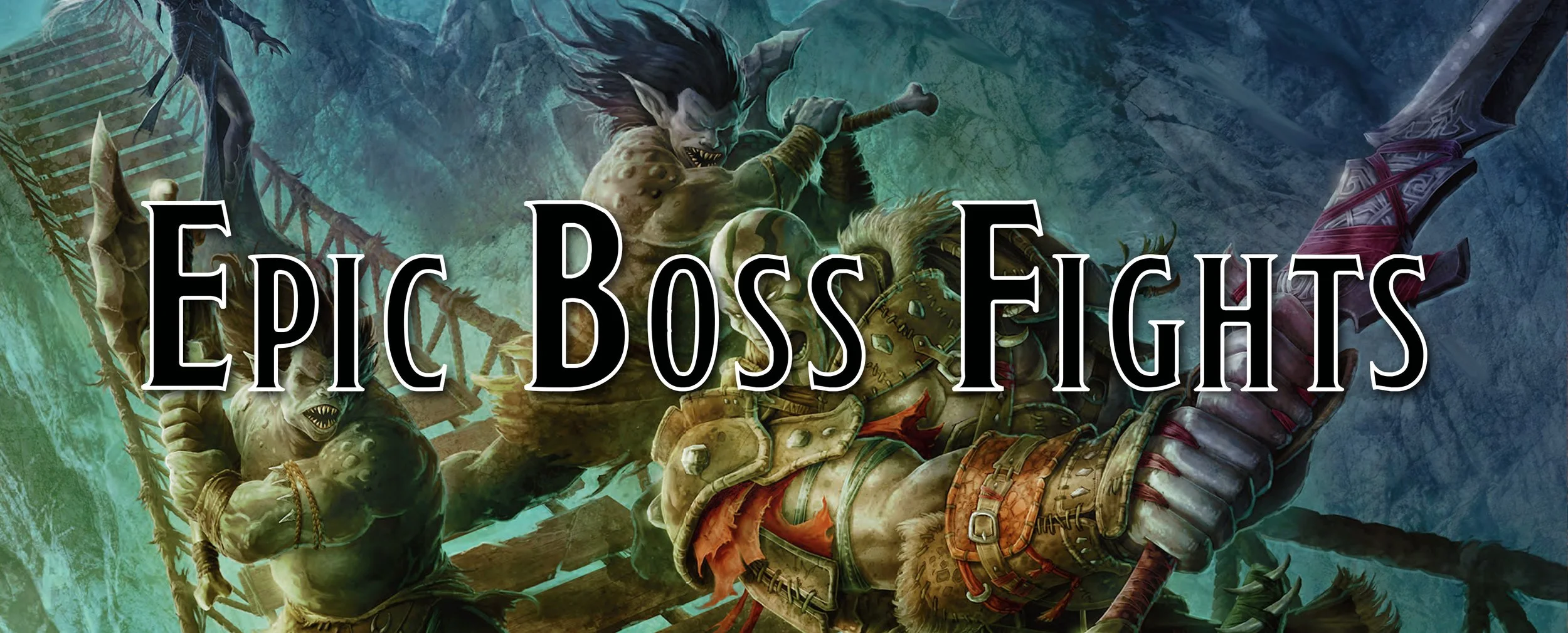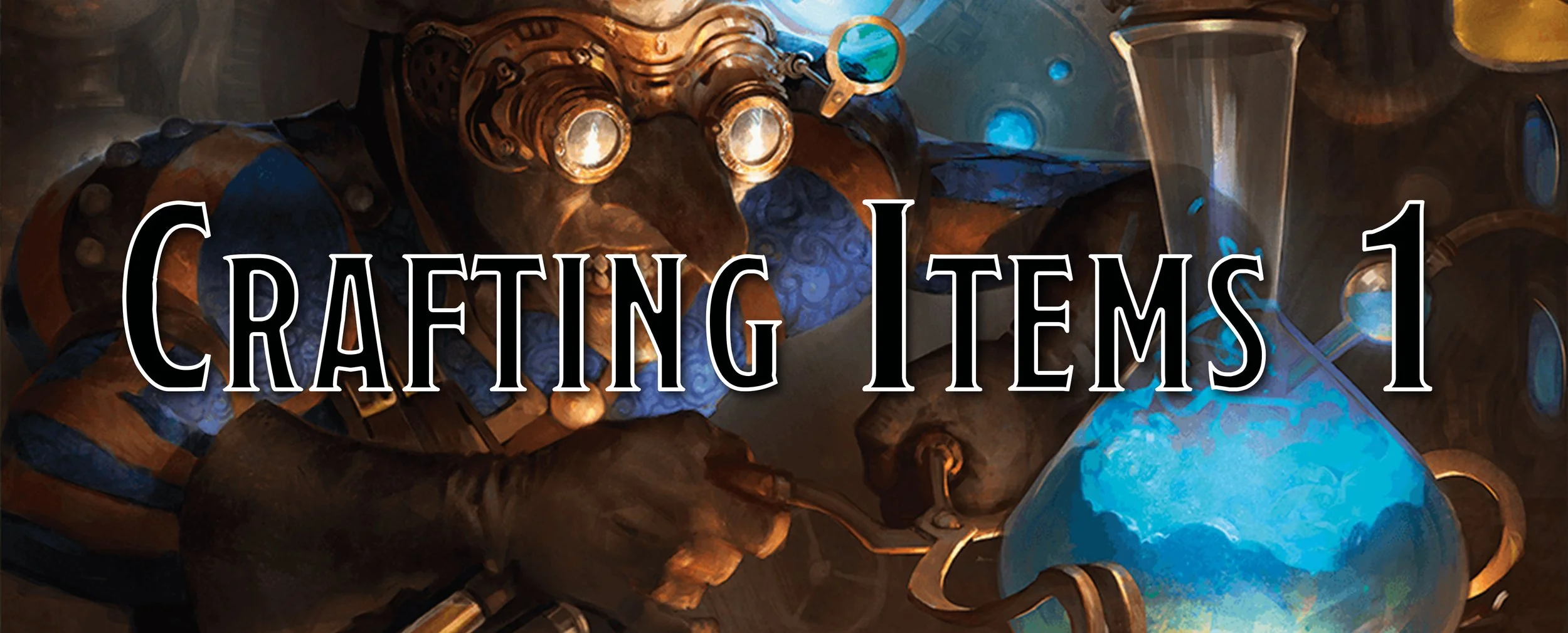How to Create Epic Boss Fights
One of the best parts about being the Game Master, you know, besides having ultimate control over the life and death of your players (and I guess their characters too), is all the planning and daydreaming. We envision these wonderful story moments that our players refuse to follow because they are too busy talking to Saltshaker the goblin bartender we named in a panic when the party wanted to haggle over a 1 copper piece beer (even though they have a literal dragon’s hoard of treasure in their bag of holding). We get to imagine all the fates that could happen in our games.
One of my favorite things to think about are boss battles. I want these fights to be intense, to have my players thinking tactically, and for the encounter to be memorable. I want my players to think, if not fondly, at least about the encounter, how they could’ve done things differently, how there were these cools moments, how they could see the combat unfolding in their mind.
Let’s delve into the secrets of creating unforgettable boss battles that will keep your players coming back to the fight. And if you need even more ideas to make unforgettable combats, then check out Hipsters & Dragons who have delved deep into designing unforgettable combats.
The Art of Epic Boss Fights
Boss fights require (as you might guess) a boss. But bosses don’t grow on trees, unless you are literally fighting a leshy spirit or your boss happens to be a treant. In which case, they do. But more than likely, you are probably pulling a monster from a Monster Manual book or creating one for your story or campaign.
Unique Identity
Your boss needs to stand out. Regardless of where you are getting your boss from, you gotta make sure your boss has a unique identity to them. They need something that helps them stand out from the horde. It doesn’t matter, so much, if your orc is a higher Challenge Rating than another orc unless they actually have something that makes them unique beyond just higher damage and hit points.
Damage and hit points are not mechanics that the players have much exposure to. Sure, they get hit. They deal damage. But it’s all abstract. Some Game Masters don’t even keep track of hit points, so that makes it even harder to figure out if the boss has more hit points starting out or if the GM just adjusted things to make it feel like the boss has more hit points.
Instead, you need something unique. This could be a unique attack where the powerful orc warlord can grapple a creature and smash them through a wall, or that the boss has one regular orc arm, and a fiend arm that allows them to shoot fireballs on their turn. But you don’t even need to be constrained by mechanics, instead, it could be all about flavor. Maybe your dragon fills their hoard with only statues of adventurers (hello, medusa minion) or your lich keeps a miniature giant space hamster and pets it like a villain with a white Persian cat.
Whatever it is that makes them unique, just make sure it comes up and the players interact with it.
The Terrain and Environment
I’ve talked a lot about the environment, and not just one that you travel through. I even made rules for fighting in a burning building. There is so much you can do with the terrain and environment, that most Game Masters normally don’t do anything with. Environmental hazards, cover, terrain, breakable scatter, and more can be utilized in such a massive variety of ways that it could stretch this post out to the length of an average Game of Thrones novel.
When envisioning the location of your boss fight, just picture what elements are also there.
Are you fighting in the ancient feasthall of a giant lord? I bet there are elk-horn chandeliers hanging on the wall that can have their cords cut, restraining any creature foolish enough to be caught under them when the chandeliers come crashing down.
Are the players taking on a vampire lord in a graveyard? There are hands in random places across the battle mat who reach out and try to grapple any creature that steps on their grave.
Is your final encounter in a large tower? What happens if the massive blasts of magic cause it to tumble down the hill and begin rolling down? How are your players going to be fighting in a literal rolling encounter?
Wherever your encounter is, there are elements you can play with, even if it is just making patches of difficult terrain that force your players to take a long path to the boss, giving them time to make ranged attacks or summon a demon.
Tension and Anticipation
Boss battles shouldn’t come out of nowhere. Instead, they should be slowly built up, giving the players opportunities to think about what is coming, what strategies they could utilize, and how they can bulk up any perceived vulnerabilities they have.
This not only makes it so that the boss is active for the encounter, but also before it. The players are anticipating the boss, making it so that the boss is a greater threat than an average mob monster who has no anticipation. Even if the boss isn’t a greater threat, mechanically, the anticipation and tension will make the boss appear like a greater threat to the party.
You can think about it like a horror movie (even if your boss isn’t horror related - like a flumph who just wants to shoot goo all over you and make friends to feed off your psychic energy). The villain is televised often, but their true abilities are not shown until the end. We see evidence of them, and so they are never a ‘surprise’ reveal at the end. We know that the villain is out there, even if we don’t have all the details.
This tension can be used by dropping hints through foreshadowing. If you want the boss to be a demon, but the party are fighting orcs - now is the time to start dropping crude unholy symbols of a demon, or the orcs have access to fiendish magic, or there seem to be a lot of sacrifices going on in the orc camp. These clues will, pardon the pun, clue the party in to the greater boss, and get them dreading (in a good way) that major encounter.
Not Alone
We all know the advice:
It’s dangerous to go alone! Take this.
But how many people actually take that to heart? Cause I see tons of people wanting to do a solo boss challenge, and then being disappointed when their boss is immediately destroyed in a round. It’s dangerous out there! Especially for a creature who, while providing a great challenge, is supposed to be surmounted by a group of plucky heroes who like to torture bartenders for cheaper drinks.
RIP Saltshaker.
Minions don’t only help your boss outlive your player’s desires, but they also provided added complexity and strategic choices. Do you handle the low-level mobs who don’t really do a lot of damage but are a nuisance, or does everyone go nova on the boss while risking the mobs? And these mobs aren’t even limited to hitting the players. They can be used to block attacks, funnel the players, or even heal the boss - making them a major nuisance to the death of the boss.
Improvise. Adapt. Overcome.
No plan survives contact with the enemy, and that goes double for contacting the players. You may have a beautiful image of your boss summoning a massive meteor swarm, killing all of the player’s NPCs so that you don’t have to run them in combat only for the bard to ruin your plans and now you are back to running thirty NPC statblocks that you were hoping to just toss in the shredder. We’ve all been there.
You need a constant willingness to alter your plans, especially if your players are working hard to thwart an evil plan. If you have a demon summoning going on, and your players are creative in stopping it - you need to honor that. Now, that doesn’t mean you have to toss the whole thing in the trashcan and mope in the corner. Instead, you shift it slightly. You tell the players that, while the demon is still summoned, thanks to their actions, it now begins attacking anyone near it, including the minions you had made to actually buff the demon.
Don’t let your ‘plan’ be the only plan allowed in the game. This is a shared-narrative game. We actually want to play this game with other people because they bring their own twist into the story. If you didn’t want anyone messing with your story, you should just write a book.
Loot
The last thing I want to say about a boss is that they should have some loot on them. Bonus points if they actually use the loot before they find themselves turned into a pile of dust.
This loot serves an important purpose. It acts as a memento of the boss fight. When the player looks on their character sheet and sees +1 plate armor made from the skull of a dragon - they aren’t just looking at random loot, but rather what obstacles they had to overcome to get that loot. They remember the fight with the boss, they remember the key moments of the encounter, and that’s what will stay with them years down the line.
In a weird way, your boss will attain a type of immortality in your players’ thoughts. They’ll carry on the stories of the boss fight to their friends, and so while your boss may have lost the battle (and their corpse brutally eviscerated by the barbarian)… it may not have lost the war of being an epic encounter.
Like what we are doing here?
Support us on Patreon!
You’ll get early access to deep dives, our Homebrew Hoard, monster stat blocks and more!
Follow us on Twitter to keep up to date on everything we talk about!



